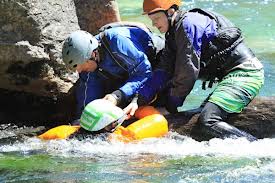 Hopefully you will never encounter this situation on the river. Cervical spine and spinal cord injuries are quite challenging even for professional rescue personnel. A major goal is do no further harm. Once you get them safely on shore, give strong consideration to calling in the professionals. They have far better tools and training than we could possibly carry.
Hopefully you will never encounter this situation on the river. Cervical spine and spinal cord injuries are quite challenging even for professional rescue personnel. A major goal is do no further harm. Once you get them safely on shore, give strong consideration to calling in the professionals. They have far better tools and training than we could possibly carry.
Contact rescues are always a last resort. Generally there are faster and much safer alternatives. Think about how you plan to get the victim and yourself to shore once you got them. On the positive side there is no set-up time and if the victim is close enough, you should be able to reach them quickly. Contact rescues are sometimes used when the victim is unconscious and can't help themselves. They may have drowned or possibly have back, neck, or head injury. You are definitely going to need some assistance with this rescue. Work as a team and have others set safety downstream. For serious C-Spine injuries, have someone get the first aid kit and gather splinting material simultaneously. Also consider sending someone to get professional help - you are going to need it to safely evacuate the victim.
